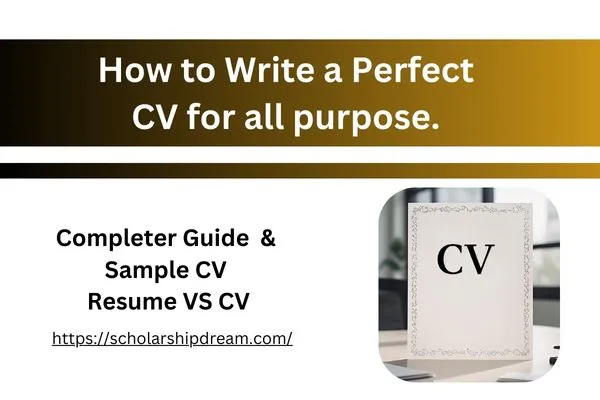How to Write a Perfect CV: A Step-by-Step Guide.
If you are student or a job seeking person then you may have search for this “How to write a Perfect CV”. In today’s competitive academic world, having a well-crafted CV can make a huge difference. Think of your CV as a gateway to your dream job and your dream scholarship it’s the document that highlights your skills, qualifications, and experience in the best possible light. In this blog, we’ll walk you through how to create a perfect CV. We’ll also break down the key differences between a CV and a resume, so you can make sure your application hits the mark.
What is a CV?
A Curriculum Vitae (CV) is a detailed document that covers your academic background, professional experience, skills, and achievements. Unlike a resume, which is typically shorter and more focused, a CV gives a comprehensive overview of your career path. It’s often used for academic, research, or international job applications.
Must Check:
How to Write a Cover Letter for a Scholarship?
How to Write Motivational Letter for Scholarship
How to get English Proficiency Certificate
CV vs Resume: What’s the Difference?
Before we dive into writing a CV, first we have to understand the difference between CV and Resume so that we may not get confused about anything.
- Length:
- CV: Usually 2-3 pages or longer if you’re a seasoned professional.
- Resume: Typically 1-2 pages.
- Purpose:
- CV: Focuses on your entire career, including academic achievements, detailed work experience, and milestones.
- Resume: Tailored to a specific job and highlights relevant skills and accomplishments.
- Content:
- CV: Includes publications, research, certifications, and a full education history.
- Resume: Focuses on job-related skills, key achievements, and work experience.
- Usage:
- CV: Commonly used for academic roles, research opportunities, or jobs abroad.
- Resume: Preferred for most corporate job applications, especially in the U.S. and Canada.
Must Follow if you haven’t yet:
Step-by-Step Guide on How to Write a Perfect CV.
1. Start with the Right Format
- Use a clean, professional layout with plenty of white space.
- Choose fonts like Arial, Times New Roman, or Calibri for easy readability.
- Divide your CV into sections with clear headings and bullet points.
2. Include Your Personal Information
- Add your full name, phone number, professional email, and LinkedIn profile.
- Skip unnecessary details like your photo (unless required), marital status, or age.
3. Write a Strong Professional Summary
- This section should be at the top of your CV and briefly summarize your career goals and key skills (3-4 sentences).
Example: “Motivated computer science graduate with experience in software development and a strong foundation in Python, Java, and data analysis. Skilled at collaborating with teams to deliver innovative solutions and streamline workflows.”
4. Highlight Your Education
- List your academic background in reverse chronological order.
- Include the name of the institution, degree, field of study, and graduation year.
Example: Bachelor of Computer Science
National University of Modern Languages.
Graduated: 2024
5. Detail Your Work Experience
- Start with your most recent job and work backward.
- Use bullet points to describe your responsibilities and achievements.
- Add numbers or metrics to make your accomplishments stand out.
Example: Freelance Web Developer
January 2023 – Present
- Designed and launched over 10 responsive WordPress websites, increasing client engagement by 30%.
- Improved website SEO, resulting in higher search rankings.
6. List Your Skills
- Create a section for technical and soft skills relevant to the job.
- Tailor the list to match the requirements of the role you’re applying for.
Example:
- Technical: Python, Java, WordPress, SEO, HTML, CSS.
- Soft: Communication, teamwork, problem-solving.
7. Add Certifications and Awards
- Include certifications that boost your credibility in the field.
- Mention awards or recognitions that showcase your achievements.
Example:
- Google Analytics Certification (2024)
- “Best Community Contributor” at Helmet Awareness Campaign (2023)
8. Include Projects and Publications
- Mention key projects or published research papers relevant to your field.
- Provide a short description of each, including outcomes or metrics where possible.
Example: Project: Scholarship Finder Website
- Built a blogging platform to help students find scholarships, attracting over 5,000 monthly visitors in six months.
9. Mention Languages
- List languages you’re proficient in and your level of fluency (e.g., native, fluent, intermediate).
Example:
- English: Fluent (IELTS)
- Urdu: Native
10. References
- This is optional. If not required upfront, you can write, “Available upon request.”

Tips for a Winning CV
- Customize for Each Job: Tailor your CV to match the job description.
- Keep it Error-Free: Proofread thoroughly to eliminate typos or grammar mistakes.
- Stay Concise: Avoid overly long descriptions—be direct and to the point.
- Use Action Words: Start bullet points with action verbs like “developed,” “managed,” or “exceeded.”
- Update Regularly: Refresh your CV with new skills, certifications, or experiences.
Link of Scholarship Maker Website:
Views: 211
